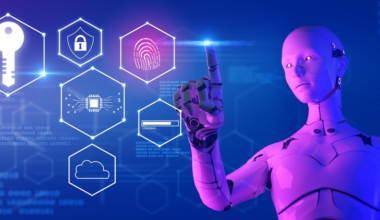The Evolution of Cyber Threat Detection: From Manual to AI-Driven
The journey of cyber threat detection has significantly evolved, transitioning from manual processes to sophisticated AI-driven methodologies. Historically, businesses depended on human analysts to identify and respond to cyber threats, a method fraught with delays and missed threats. The advent of artificial intelligence (AI) has revolutionized this field, making the process more efficient and accurate.
AI-powered cyber threat detection systems can analyze vast amounts of data in real-time, identifying patterns and anomalies that may signal potential threats. This automation allows businesses to swiftly detect and respond to cyber threats, minimizing the risk of data breaches and other cyber attacks. The ability of AI to learn and adapt continuously enhances the accuracy of these systems, providing comprehensive protection against both known and unknown threats.
Leveraging AI for Advanced Cyber Threat Prediction in Modern Enterprises
In the face of increasingly sophisticated cyber threats, modern enterprises require advanced prediction capabilities. AI plays a pivotal role in this arena by utilizing machine learning algorithms to analyze historical data and identify patterns indicative of future attacks. By studying past cyber attacks and their outcomes, AI models can recognize the characteristics of different threats, allowing businesses to proactively address potential vulnerabilities and mitigate risks.
AI-powered cyber threat prediction systems also offer actionable insights and recommendations to strengthen security measures. These systems integrate data from various sources, such as network logs, user behavior, and external threat intelligence feeds, to prioritize potential threats based on their severity. This comprehensive analysis helps businesses enhance their security posture and stay ahead of cybercriminals.
How AI Enhances Real-Time Threat Identification and Response
Real-time threat identification and response are crucial for businesses aiming to prevent cyber attacks and minimize the impact of breaches. AI enhances these capabilities by enabling the rapid analysis of large volumes of data and generating timely alerts when potential threats are detected.
AI-powered systems continuously monitor network traffic, log files, and other data sources to identify anomalies and suspicious activities. By leveraging machine learning algorithms, these systems can discern patterns and behaviors associated with both known and unknown threats, enabling businesses to respond promptly and effectively. Moreover, AI can automate the response process by implementing predefined security policies, such as blocking suspicious IP addresses or initiating incident response procedures, thereby reducing the burden on human analysts and improving response times.
AI in Cybersecurity
AI is revolutionizing the field of cybersecurity, enabling businesses to detect, prevent, and respond to cyber threats more efficiently. The increasing complexity and volume of threats render traditional security measures insufficient. AI-powered systems can analyze vast data sets in real-time, identifying patterns and anomalies indicative of potential threats. This capability allows businesses to respond swiftly to cyber attacks, reducing the risk of data breaches and other security incidents.
Furthermore, AI can help businesses stay ahead of cybercriminals by continuously learning and adapting to new threats. By analyzing and correlating data from multiple sources, AI models can identify potential vulnerabilities and prioritize them based on their severity, providing businesses with a high-tech shield in the digital age.
The Role of Machine Learning in Predicting and Preventing Attacks
Machine learning is integral to predicting and preventing cyber attacks. By analyzing large data volumes and identifying patterns, machine learning algorithms can detect potential threats and implement proactive measures to prevent them.
Machine learning models learn from historical data, recognizing the characteristics of various attack types. This capability allows businesses to anticipate and mitigate potential vulnerabilities before they can be exploited by cybercriminals. Moreover, as these algorithms process more data and encounter new threats, they continuously improve in accuracy and effectiveness, ensuring that businesses remain protected against a wide range of cyber threats, including malware, phishing attacks, ransomware, and insider threats.
AI and Advanced Persistent Threats (APTs)
Advanced Persistent Threats (APTs) present a significant challenge due to their stealthy nature and ability to evade traditional security measures. AI is crucial in combating APTs by detecting and responding to their activities in real-time. AI-powered APT detection systems analyze large volumes of data from various sources, such as network logs and endpoint telemetry, to identify patterns and behaviors associated with APTs.
These systems can raise alerts and initiate response actions to neutralize threats. Moreover, AI can uncover hidden APTs that may have bypassed traditional security measures, providing early warning signs to prevent potential data breaches. By leveraging AI technologies that continuously learn and adapt to evolving threats, businesses can protect their critical data and infrastructure from sophisticated cyberattacks.
Future Trends and Innovations
The field of AI in cyber threat detection is rapidly evolving, with new trends and innovations continually emerging to address the ever-changing threat landscape. Key future trends include:
- Increased use of AI-powered threat hunting techniques to proactively search for potential threats and vulnerabilities within an organization’s network.
- Integration of AI with other cybersecurity technologies, such as cloud security and endpoint protection, to provide a holistic defense against cyber threats.
- Adoption of explainable AI in cybersecurity to enhance transparency and trust in AI systems, allowing analysts to understand and validate AI-driven decisions.
- Use of AI to automate threat intelligence analysis and sharing, enabling faster dissemination of threat information and collaboration between organizations.
- These trends promise to further enhance AI’s capabilities in cyber threat detection, empowering businesses to protect their digital assets and stay ahead of cybercriminals.
AI in Cybersecurity: Ethical Considerations and Data Privacy
While AI offers significant benefits in cybersecurity, it also raises ethical considerations and data privacy concerns. As AI systems analyze vast amounts of data, including personal and sensitive information, it is crucial to ensure the responsible and ethical use of AI in cybersecurity.
Businesses must adhere to legal and regulatory frameworks governing data privacy and security. They should implement robust data protection measures, such as encryption and access controls, to safeguard the privacy and confidentiality of user data. Moreover, businesses should be transparent about using AI in cybersecurity and educate their users about the data collected, how it is used, and the security measures in place to protect it. Building trust and maintaining open communication with users is essential to ensure the responsible deployment of AI technologies.
Additionally, organizations should regularly assess the fairness and bias of their AI models to avoid unintended discrimination or unfair treatment. They should strive for diversity and inclusivity in their training data sets to minimize bias and ensure equitable outcomes. By addressing these ethical considerations and prioritizing data privacy, businesses can harness the power of AI in cybersecurity while maintaining the trust and confidence of their users.

Future Trends: What’s Next for AI in Cyber Threat Detection?
The future of AI in cyber threat detection holds immense potential for further advancements. Key trends to watch include:
- Increased use of AI-powered threat intelligence platforms that aggregate and analyze threat data from various sources to provide comprehensive threat insights.
- Integration of AI with blockchain technology to enhance the security and integrity of data exchanges, reducing the risk of data tampering and unauthorized access.
- Development of AI-powered deception technologies that can mislead and confuse attackers, complicating their infiltration attempts.
- Application of AI in user behavior analytics to identify anomalous activities and detect insider threats more effectively.
- These trends promise to revolutionize cyber threat detection, empowering businesses with advanced capabilities to protect their digital assets and stay one step ahead of cybercriminals.
Additional Keywords Integration
For those seeking to enhance their skills in this domain, pursuing a cyber security course in Delhi or enrolling in cyber security courses in Delhi can be highly beneficial. Numerous institutes offer comprehensive cyber security training, providing learners with the knowledge and skills required to tackle modern cyber threats. Look for the best cyber security institute in Delhi to ensure high-quality education and training. Many institutes also offer cyber security certifications online, allowing for flexible learning options. These certifications are valuable for validating your skills and enhancing your career prospects in the field of cybersecurity. Whether you opt for cyber security courses online or attend cyber security classes in person, obtaining cyber security certifications is a crucial step towards becoming a proficient cybersecurity professional.






1 comment
I was recommended this website by my cousin I am not sure whether this post is written by him as nobody else know such detailed about my difficulty You are wonderful Thanks